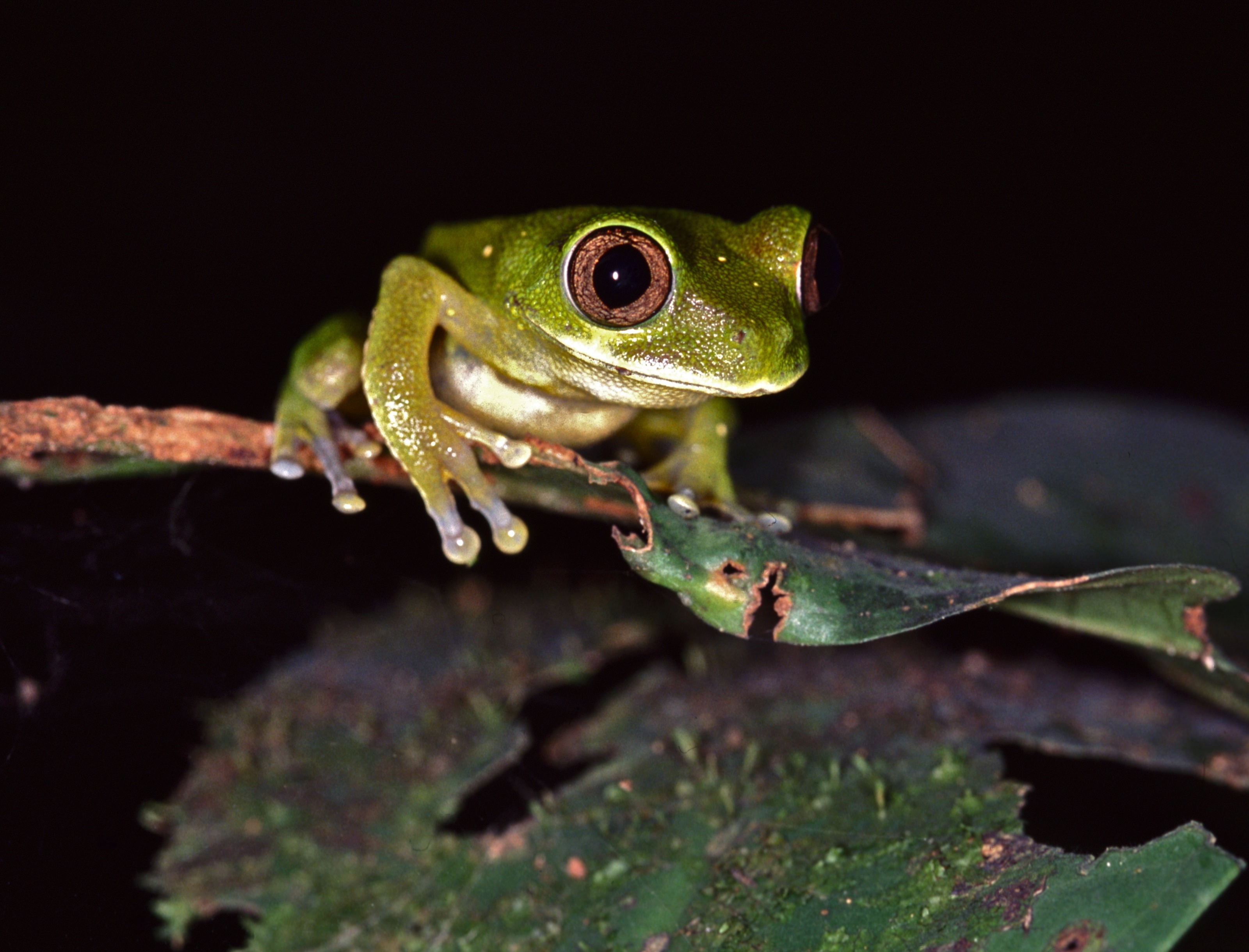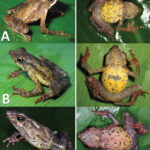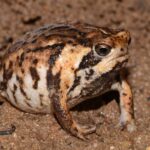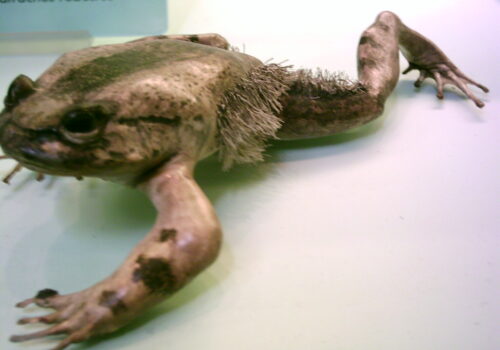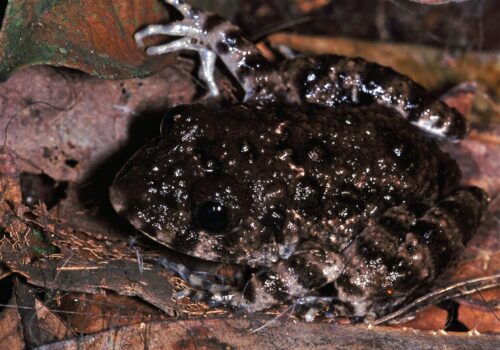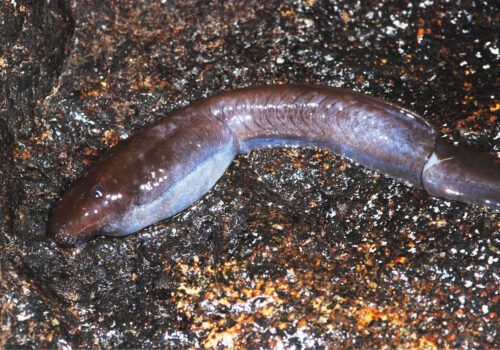- The Cameroon Forest Tree Frog: Exploring the Enchanting World of <em>Leptopelis brevirostris</em>
- Taxonomy and Classification
- Natural Habitat: Life Among the Leaves
- Physical Characteristics: Brilliantly Adapted to Forest Life
- Behavior and Life Cycle: Forest Melodies and Hidden Lives
- Ecological Role: Guardians of the Rainforest Balance
- Threats and Conservation Status: Dancing on the Edge
- Cultural and Scientific Significance: Icons and Insights
- Conclusion: A Legacy of Precise Harmony and Fragility
The Cameroon Forest Tree Frog: Exploring the Enchanting World of Leptopelis brevirostris#
Deep within the mystifying embrace of the central African rainforest, cloaked by dense foliage and caressed by eternal mist, lives a charming yet elusive creature, the Cameroon Forest Tree Frog (Leptopelis brevirostris). Often overlooked amidst the lush tapestry of life thriving in Equatorial Africa, this fascinating amphibian hides secrets of survival, beauty, and ecological significance. As tiny ambassadors of the rainforest canopy and undergrowth, the Cameroon Forest Tree Frog’s tale is one of resilience, delicate balance, and vibrant biodiversity.
Remarkably eye-catching with their emerald hues and delicate build, Leptopelis brevirostris has captured the curiosity of naturalists and researchers alike for decades. Although small in stature, this species performs a crucial role within its native ecosystem, providing essential clues into the health and integrity of tropical humid forests. Before we journey deeper into the intriguing life and role of this frog, let’s first acquaint ourselves with its scientific heritage and unique taxonomy.
Taxonomy and Classification#
The Cameroon Forest Tree Frog’s scientific classification places it firmly within the family Arthroleptidae, a diverse group known colloquially as the forest, river, and bush frogs. Within this family resides the expansive and fascinating genus Leptopelis, currently comprising over 50 distinct species scattered predominantly across Sub-Saharan Africa.
The suitability of its scientific denomination, Leptopelis brevirostris, is notable: “Leptopelis” derives from Greek roots meaning “slender pelvis,” indicative of skeletal adaptations observed in this arboreal genus. “Brevirostris” translates simply to “short-snouted,” referencing this species’ distinctive small head and truncated facial profile.
Closely related species within the genus, such as Leptopelis calcaratus and Leptopelis aubryi, similarly inhabit the verdant realms of central and western Africa. Although visually similar, detailed morphological and genetic analyses have given Leptopelis brevirostris a secure status as a distinct species, celebrated for its specialized traits adapted to its preferred forest habitats.
Natural Habitat: Life Among the Leaves#
The Geographic Range#
Native primarily to Cameroon, Equatorial Guinea, Nigeria, and parts of Gabon and Republic of Congo, the Cameroon Forest Tree Frog inhabits a relatively restricted geographic range within Central and West Africa. The species’ heartland centers squarely within the luxuriant confines of mature lowland rainforests, montane forests, and occasionally cloud forests, from sea level upwards to altitudes of about 1,500 meters.
This relatively narrow distribution heightens both its ecological value and vulnerability. Remote, dense forest patches serve as strongholds for robust amphibian populations, yet as human expansion engulfs the region, these fragmented habitats present unique conservation challenges.
A Symphony of Rain and Leaves: Preferred Habitat#
Within their preferred landscapes, Leptopelis brevirostris seeks refuge in the microcosm of leaves, vines, roots, and branches—typically favoring shady, low-hanging vegetation near softly flowing streams and seasonal ponds. Each moist night brings renewed activity, as frogs descend to lower branches or to leaf litter nearby, taking advantage of an abundant food source.
The rainforest’s architecture—designed by nature over millennia—fits perfectly with their arboreal lifestyle. Ambient moisture sustains their delicate bodies, aiding in moisture retention vital to amphibian health, while dense vegetation ensures protection from predators and competition alike. This intricate forest ecosystem, abundant in insects and providing sheltered breeding sites, represents the ultimate organic niche perfectly tailored for amphibian life.
Physical Characteristics: Brilliantly Adapted to Forest Life#
A Jewel of the Forest Canopy#
To gaze upon the Cameroon Forest Tree Frog is to encounter a living gem set within emerald leaves. Adults typically measure between 30 to 45 millimeters in total length, markedly small but wonderfully proportional. Their vibrant green bodies, occasionally tinted with subtle hues of yellow, tan, or blueish tones in certain populations, render exceptional camouflage amidst foliage, deftly evading vigilant predators.
A closer inspection reveals the species’ hallmark short snout, lending it a distinctive, somewhat rounded visage. Large, expressive eyes dominate their small heads, reflecting the forest around them and emphasizing their visually-oriented behaviors. Toe pads, expanded and adhesive, give testament to their arboreal aptitude, enabling effortless perching, climbing, and leaping from plant to plant.
Adaptive Advantage: Camouflage and Agility#
Camouflage is an essential survival strategy deeply etched into the evolutionary story of Leptopelis brevirostris. Their coloration and subtle patterning blend dynamically with surrounding foliage, becoming near-invisible amidst rain-drenched branches and leaves. Such natural disguise offers protection from visual predators such as birds, snakes, and even larger frogs.
Not content with solely blending into their surroundings, these agile frogs rely heavily on rapid, precise leaps to avoid predation and capture prey. The seemingly effortless agility is paired with exceptional landing finesse—abilities shaped over thousands of generations, finely tuning their anatomy for the treetop lifestyle.
Behavior and Life Cycle: Forest Melodies and Hidden Lives#
Diet and Feeding Habits#
Nightfall in the rainforest heralds a busy period for frogs, brimming with hungry appetites. Leptopelis brevirostris, as an insectivorous amphibian, satisfies its energy demands through skillful predation of soft-bodied insects and arachnids. Small beetles, crickets, spiders, and various moth species feature prominently in their diets, providing rich sources of protein and fats necessary for continuous growth and reproductive energy.
Mating Rituals and Courtship: A Forest Symphony#
The most captivating aspect of their behavior is arguably their melodious mating chorus, echoing beautifully across the rainforest canopy during wet seasons. Males, motivated by reproductive urgency, establish positions near suitable water bodies, proclaiming vigor and dominance through resonant vocalizations. Each frog shapes its own unique call, an acoustically complex advertisement that directs females to potential mates.
Females, guided by auditory cues, select suitable suitors based on call quality, clarity, and intensity—indicators that carry valuable hidden markers of genetic fitness and physical health. Post-mating rituals culminate in egg-laying within quiet, shaded pools and slow waterways, carefully chosen for optimal tadpole survival.
The Transformation Journey: Tadpole to Forest Acrobat#
After hatching, tadpoles embark on a perilous yet transformative journey—a metamorphosis encompassing considerable physiological and anatomical adjustment. Their larval stage, spent within pools rich in algae and detritus, prepares them for terrestrial fidelities; limbs sprout, lungs develop, and delicate tails are slowly absorbed until juvenile frogs emerge, ready to ascend into their arboreal destinies.
Ecological Role: Guardians of the Rainforest Balance#
Amphibians like Leptopelis brevirostris exert profound influence within their ecosystems. Representing critical trophic links, these frogs serve both predator and prey roles, helping maintain balanced insect populations while sustaining biodiversity by becoming nourishment for higher trophic animals. Furthermore, due to their porous skins and sensitivity to environmental changes, these frogs act as critical bioindicators, alerting ecologists to precursory signs of ecosystem health or decline.
Threats and Conservation Status: Dancing on the Edge#
Unfortunately, the Cameroon Forest Tree Frog’s fragile existence remains threatened by habitat destruction, logging practices diminishing pristine forest landscapes, expanding agricultural frontiers, and climate irregularities exacerbated by global warming. The species is currently classified as “Least Concern” by the IUCN Red List, benefiting from relative numerical stability—but its vulnerable ecological position implies that escalating threats could swiftly alter its conservation narrative.
Cultural and Scientific Significance: Icons and Insights#
Locally recognized as symbols of forest fertility and purity, these frogs embed themselves deep within traditional lore. Scientifically, their resilience and unique adaptations have alerted researchers worldwide to amphibian lives’ remarkable diversity and adaptability, illuminating areas of exploration regarding ecological indicators, toxin studies, and climate-change sensitivity.
Conclusion: A Legacy of Precise Harmony and Fragility#
As custodians and stewards of natural heritage, we shoulder collective responsibility to safeguard these hidden wonders. The delicate guardianship role Leptopelis brevirostris represents should be cherished—a rare fulfillment of beauty, functionality, and evolutionary wonderment, encouraging each of us to speak, act, and advocate passionately for rainforests’ tranquility and biodiversity.


